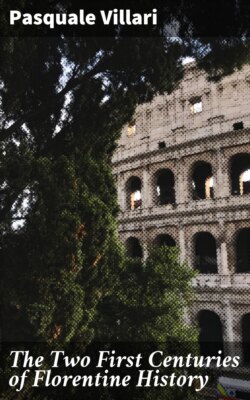Читать книгу The Two First Centuries of Florentine History - Pasquale Villari - Страница 16
На сайте Литреса книга снята с продажи.
IV.
ОглавлениеTable of Contents
For on all sides, if in diverse modes, we perceive that a long period of incubation was needed to form the Commune, which naturally owed its birth to pre-existing elements. The celebrated agreement or concordia made at Pisa by Bishop Daiberto, about 1090, or even, perhaps, a year or so earlier,98 shows that the nobles were organised and waging fierce war against one another from their towers. The bishop induced them to partly demolish these towers, and solemnly vow never to carry them above the height of thirty-six braccia (about one hundred feet), as previously decreed by the patent of Henry IV. in 1081.99 And the agreement proceeded to set forth that any man believing his houses to have been unjustly damaged was to bear his complaint ad commune Colloquium Civitatis; nor could the dwelling of the offender be demolished without the general consent of the citizens.100
MOUTH OF ROMAN FURNACE,
Discovered beneath the Mercato Vecchio.
CALIDARIUM.
Ibid.
[To face page 96.
The whole tenor of this document not only proves that the Pisan nobles were already an organised body, but that they also boasted a civic importance never attained by the nobles of Florence.101 Evidently Pisa had no Consuls as yet, or they would have been certainly mentioned in the document. But all the elements destined to make it a far more aristocratic commune than that of Florence were already existent.102 We see that there was a commune consilium of sapientes or boni homines, which was a species of senate, and a commune colloquium, a general assembly of all the citizens, afterwards developing into a parliament or arrengo. Five sapientes, whose names are given, sat in council with the bishop.103 These were the immediate precursors or, as Pawinski rightly calls them, the vorbilder of the Consuls, who are actually mentioned shortly after this time, in 1094, in another agreement (concordia), also drawn up by Daiberto. He makes an explicit appeal to their authority (huius civitatis consulibus) in decreeing that all smiths engaged on work required for the Duomo should be left unmolested.104 Thus the rise of the Pisan Commune was preceded by a conflict waged by belligerent nobles from their respective towers, and the Consuls of the town were first named as the protectors of the smiths.
The existence of guilds in Venice as far back as the ninth century is certified by the Altino Chronicle, proving that, even then, there were some leading industries exercised by certain families only, and that humbler trades, or ministeria, were already constituted, as it were, in associations, the members of which pursued their avocation according to traditional and definite rules. These craft-guilds or ministeria implied certain accompanying obligations, since all members of them were bound to yield some gratuitous service to the State. On the other hand, the higher trades, such as mosaic work, architecture, and so on, requiring more culture and talent, were exercised by the leading families, and members of these guilds remained eligible for the political offices of the State.105 There is a document of the eleventh century showing that the guild of smiths was constituted under the rule of a gastaldo (or steward), against whom one of the members appealed for justice to the doge, according to a custom as yet unwritten.106 All this compels us to believe that the existence of art and trade guilds, and in general of all the associations into which the citizens of the communes were afterwards divided, dates from a very remote period, and that in Florence, as elsewhere, all similar associations were constituted before the Commune had proclaimed its independence. Otherwise it would be impossible to explain the existence of a city that, almost without any visible government, was already prosperous in commerce and able to make war on its own account. For otherwise all the ensuing facts, although beyond the reach of doubt, would remain unexplained.
